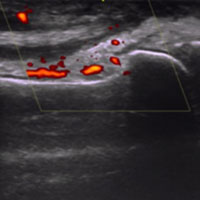Hand dominance in early and established rheumatoid arthritis: evaluation by dynamometer, Ritchie index and musculoskeletal ultrasound: a cross sectional study

Submitted: 5 February 2020
Accepted: 31 August 2020
Published: 19 November 2020
Accepted: 31 August 2020
Abstract Views: 1072
PDF: 642
Publisher's note
All claims expressed in this article are solely those of the authors and do not necessarily represent those of their affiliated organizations, or those of the publisher, the editors and the reviewers. Any product that may be evaluated in this article or claim that may be made by its manufacturer is not guaranteed or endorsed by the publisher.
All claims expressed in this article are solely those of the authors and do not necessarily represent those of their affiliated organizations, or those of the publisher, the editors and the reviewers. Any product that may be evaluated in this article or claim that may be made by its manufacturer is not guaranteed or endorsed by the publisher.
Similar Articles
- P. Dieppe, L. Loe, L. Shepstone, I. Watt, What ‘skeletal paleopathology’ can teach us about arthritis. The contributions of the late Dr Juliet Rogers , Reumatismo: Vol. 58 No. 2 (2006)
- M. Vadacca, D. Margiotta, D. Sambataro, F. Buzzulini, M. Lo Vullo, A. Rigon, A. Afeltra, BAFF/APRIL pathway in Sjögren syndrome and systemic lupus erythematosus: relationship with chronic inflammation and disease activity , Reumatismo: Vol. 62 No. 4 (2010)
- V. Bruzzese, C. Marrese, P. Scolieri, J. Pepe, Psoriatic spondyloarthritis and Sjögren syndrome: a casual association? , Reumatismo: Vol. 72 No. 3 (2020)
- P. Clini, A. Stimamiglio , D. Camellino, E. Hysa, M. Cutolo, M.A. Cimmino, Management of giant cell arteritis among general practitioners from Genoa, Italy: a web-based survey , Reumatismo: Vol. 72 No. 4 (2020)
- U. Fiocco, P. Sfriso, F. Oliviero, F. Sovran, E. Scagliori, E. Pagnin, M. Vezzù, L. Cozzi, C. Botsios, R. Nardacchione, A. Di Maggio, L. Rubaltelli, C. Giacometti, F. Calabrese, S. Todesco, Intra-articular etanercept treatment for severe diffuse pigmented villonodular knee synovitis , Reumatismo: Vol. 58 No. 4 (2006)
You may also start an advanced similarity search for this article.

 https://doi.org/10.4081/reumatismo.2020.1273
https://doi.org/10.4081/reumatismo.2020.1273




